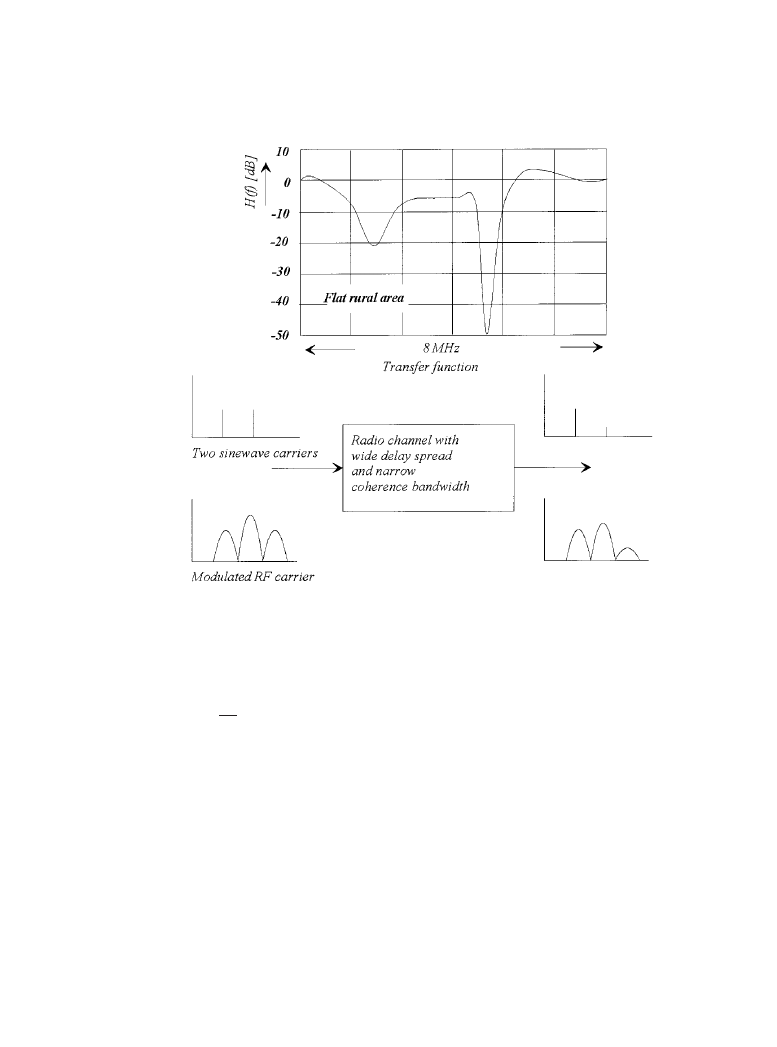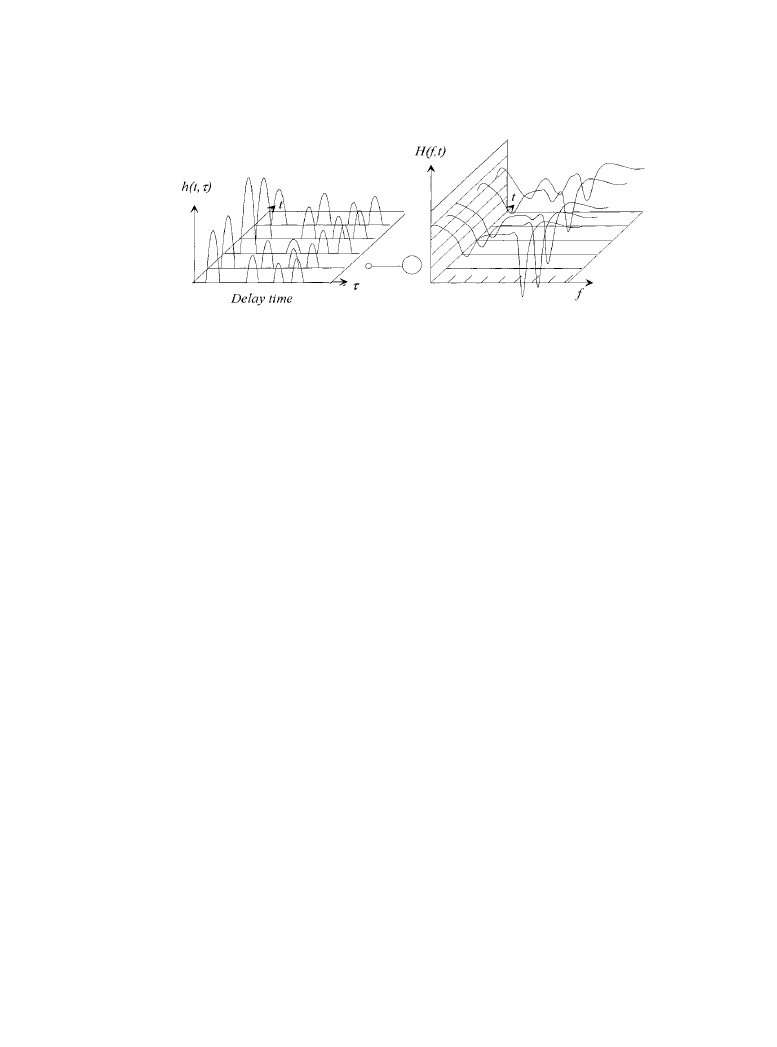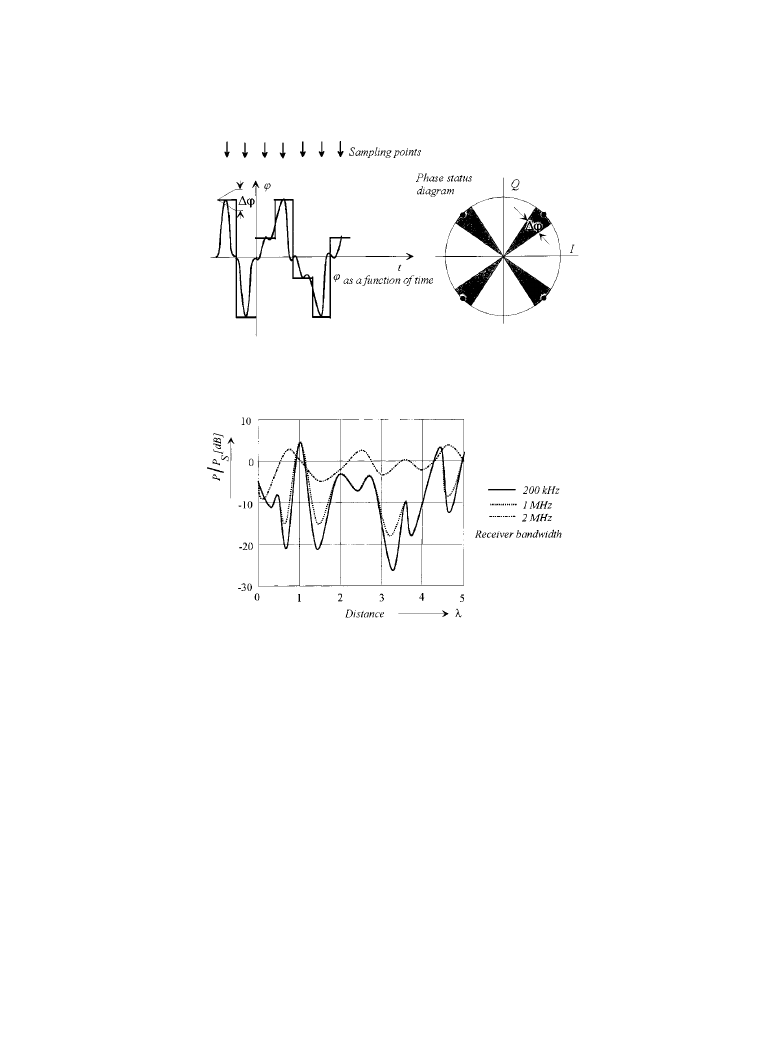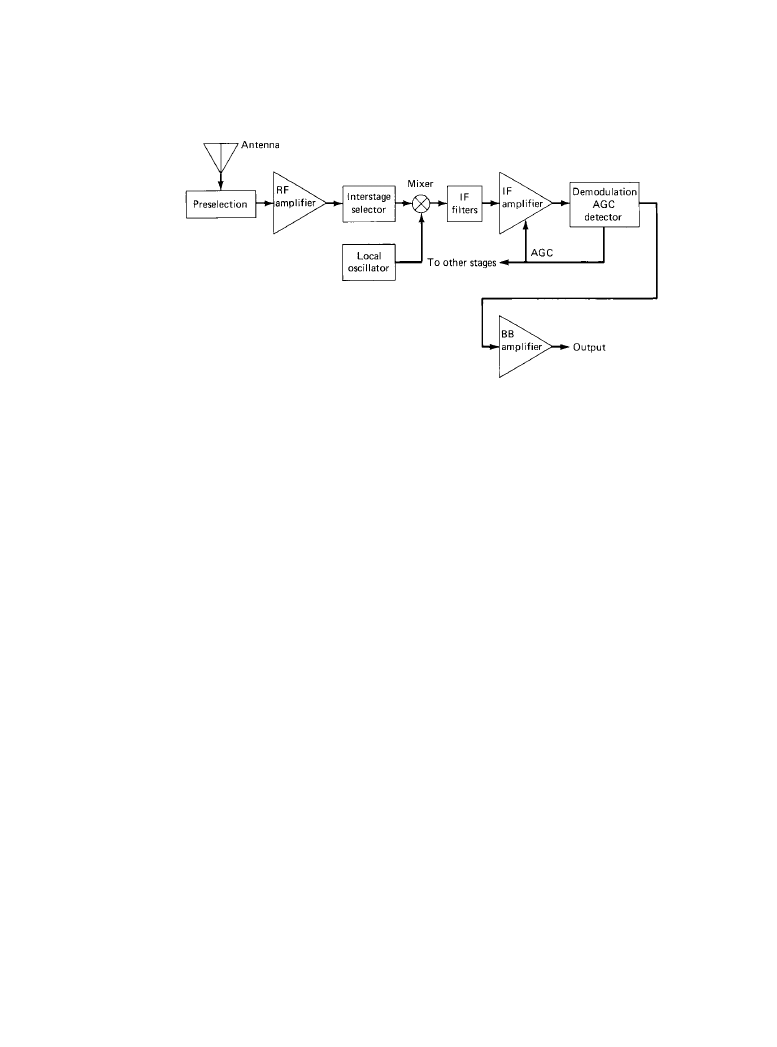ВУЗ: Казахская Национальная Академия Искусств им. Т. Жургенова
Категория: Книга
Дисциплина: Не указана
Добавлен: 03.02.2019
Просмотров: 21614
Скачиваний: 19

12-38 Broadcast Receiver Systems
(12.2.5)
If the coherence bandwidth is sufficiently wide and—consequently—the associated delay
spread is small, the channel is not frequency-selective. This means that all frequencies are sub-
ject to the same fading. If the coherence bandwidth is narrow and the associated delay spread
wide, even very close adjacent frequencies are attenuated differently by the channel. The effect
on a broadband-modulated carrier with respect to the coherence bandwidth is obvious. The side-
bands important for the transmitted information are attenuated to a different degree. The result is
a considerable distortion of the receive signal combined with a high bit error rate even if the
received field strength is high. This characteristic of the radio channel again speaks for the use of
narrowband modulation methods. (See Figure 12.2.13).
( )
∆f
T
c
d
=
1
Figure 12.2.13
Effect of transfer function on modulated RF signals. (
Courtesy of Rohde &
Schwarz.)
Downloaded from Digital Engineering Library @ McGraw-Hill (www.digitalengineeringlibrary.com)
Copyright © 2004 The McGraw-Hill Companies. All rights reserved.
Any use is subject to the Terms of Use as given at the website.
The Radio Channel

The Radio Channel 12-39
12.2.1d
Time Response of Channel Impulse Response and Transfer Function
The time response of the radio channel can be derived from the Doppler spread. It is assumed
that the channel rapidly varies at high vehicle speeds. The time variation of the radio channel can
be described by a figure, the coherence time, which is analogous to the coherence bandwidth.
This calculated value is the reciprocal bandwidth of the Doppler spectrum. A wide Doppler spec-
trum therefore indicates that the channel impulse response and the transfer function vary rapidly
with time, as shown in Figure 12.2.14. If the Doppler spread is reduced to a single line, the chan-
nel is time-invariant. In other words, if the vehicle has stopped or moves at a constant speed in a
terrain without reflecting objects, the channel impulse response and the transfer function mea-
sured at different times are the same.
The effect on information transmission can be illustrated with a simple example. In the case
of MPSK modulation using hard keying, the transmitter holds the carrier phase for a certain
period of time; that is, for the symbol period T. In the case of soft keying with low-pass-filtered
baseband signals for limiting the modulated RF carrier, the nominal phase is reached at a spe-
cific time—the sampling time. In both cases the phase error
ϕ
f
= f
dTS
is superimposed onto the
nominal phase angle, which yields a phase uncertainty of
∆ϕ = 2ϕ
f
at the receiver. The longer the
symbol period, the greater the angle deviation (Figure 12.2.15). Considering this characteristic of
the transmission channel, a short symbol period of T
s
<< (
∆t)
c
should be used. However, this
requires broadband modulation methods.
Figure 12.2.16 shows the field strength or power arriving at the mobile receiver if the vehicle
moves in a Rayleigh distribution channel. Because the phase depends on the vehicle position, the
receiver moves through positions of considerably differing field strength at different times (time-
dependence of radio channel). In the case of frequency-selective channels, this applies to one fre-
quency only; that is, to a receiver using a narrowband IF filter for narrowband emissions. As Fig-
ure 12.2.16 shows, this effect can be reduced by increasing the bandwidth of the emitted signal
and consequently the receiver bandwidth.
Figure 12.2.14
Channel impulse response and transfer function as a function of time. (
Courtesy of
Rohde & Schwarz.)
Downloaded from Digital Engineering Library @ McGraw-Hill (www.digitalengineeringlibrary.com)
Copyright © 2004 The McGraw-Hill Companies. All rights reserved.
Any use is subject to the Terms of Use as given at the website.
The Radio Channel

12-40 Broadcast Receiver Systems
12.2.2 References
1.
Rohde, Ulrich L., and David P. Newkirk: RF/Microwave Circuit Design for Wireless Appli-
cations, John Wiley & Sons, New York, N.Y., 2000.
Figure 12.2.15
Phase uncertainty caused by Doppler effect. (
Courtesy of Rohde & Schwarz.)
Figure 12.2.16
Effect of bandwidth on fading. (
Courtesy of Rohde & Schwarz.)
Downloaded from Digital Engineering Library @ McGraw-Hill (www.digitalengineeringlibrary.com)
Copyright © 2004 The McGraw-Hill Companies. All rights reserved.
Any use is subject to the Terms of Use as given at the website.
The Radio Channel

12-41
Chapter
12.3
AM and FM Receivers
Jerry C. Whitaker, Editor-in-Chief
12.3.1 Introduction
1
A simplex transmitter-receiver system is the simplest type of communication system possible. A
single source transmits to a single receiver. When the receiver can respond to a transmission
from the source and relay voice or other information back to the transmission site, a duplex
arrangement is realized. A two-way business radio system operating on different transmit and
receive frequencies employs a duplex arrangement. AM and FM broadcast systems utilize a sim-
plex star configuration in which one transmitter feeds many receivers. For greatest efficiency,
the receivers in a simplex star should be made as simple as possible, concentrating technical
complexity at the transmit site. Radio broadcasting today follows this basic rule.
AM and FM stations transmit at high power levels to facilitate simpler radio designs. AM sta-
tions in the U.S. can operate at up to 50 kW, while FM stations can operate at up to 100 kW. This
essentially eliminates the need for a sensitive antenna at the receiver. Stereo AM and stereo FM
systems are, likewise, designed to permit the more complex operations to be performed in the
encoding stage at the transmitter, rather than in the decoding circuits of the receiver.
12.3.1a Superheterodyne Receiver
Virtually every AM-FM radio manufactured today incorporates the superheterodyne method of
reception. This system makes use of the heterodyne principle of mixing an incoming signal with
a signal generated by a local oscillator (LO), as illustrated in Figure 12.3.1. The LO is offset by a
fixed intermediate frequency (IF) from the desired signal. Because the mixer (a nonlinear
device) generates a difference frequency that is identical if the desired signal is either above or
below the LO frequency (and also a number of other spurious responses), filtering is required
prior to the mixer to suppress the undesired signal. The frequency of the undesired signal is
referred to as an image frequency and is separated from the desired signal frequency by a differ-
ence equal to twice the IF.
1. Portions of this chapter were adapted form Rohde, Ulrich L., and Jerry C. Whitaker: Commu-
nications Receivers, 3rd ed., McGraw-Hill, New York, N.Y., 2000. Used with permission.
Downloaded from Digital Engineering Library @ McGraw-Hill (www.digitalengineeringlibrary.com)
Copyright © 2004 The McGraw-Hill Companies. All rights reserved.
Any use is subject to the Terms of Use as given at the website.
Source: Standard Handbook of Audio and Radio Engineering

12-42 Radio Receivers
Channel filtering is accomplished by one or more fixed-frequency filters in the IF. This is a
decided advantage when the receiver must cover a wide frequency band, bccausc it is more diffi-
cult to maintain constant bandwidth in a tunable filter than in a fixed one. An IF frequency of
455 kHz is used for AM receivers and 10.7 MHz for FM receivers.
As shown in Figure 12.3.1, the input signal is fed from the antenna to a preselector filter and
RF amplifier. The input circuit matches the antenna to the first amplifying device to achieve the
best sensitivity. It also provides the necessary selectivity to reduce the possibility of overload in
the first amplifier stage caused by strong, undesired signals. Because sufficient selectivity must
be provided to eliminate the image and other spurious signals prior to the mixer, preselection fil-
tering may he broken into two or more parts with intervening amplifiers (in premium receiver
designs) to minimize the effects of filter losses on the receiver noise figure (NF). The noise fig-
ure is a comparison in decibels (dB) of the noise power generated by a receiver with the noise
power generated in an equivalent resistor.
The LO provides a strong stable signal at the proper frequency to the mixer for conversion of
the desired signal to the IF. (The mixer stage may also be called the first detector, converter, or
frequency changer.) The operating frequency of the LO may be controlled by a variable capacitor
or varactor diode operating in a phase-locked-loop (PLL) system. Frequency synthesizer PLL
designs are the basis for electronically-tuned radios (ETRs).
The output of the mixer is applied to the IF amplifier, which raises the desired signal to a suit-
able power level for the demodulator. The demodulator derives from the IF signal the modulated
baseband waveform, which may be amplified by a baseband amplifier before being applied to a
decoder (for stereo broadcasts) or audio preamplifier (for monophonic broadcasts).
Figure 12.3.1
Simplified block diagram of a superheterodyne receiver. Depending on the sophisti-
cation of the radio, some of the stages shown may be combined into a single circuit. (
From [1].
Used with permission.)
Downloaded from Digital Engineering Library @ McGraw-Hill (www.digitalengineeringlibrary.com)
Copyright © 2004 The McGraw-Hill Companies. All rights reserved.
Any use is subject to the Terms of Use as given at the website.
AM and FM Receivers